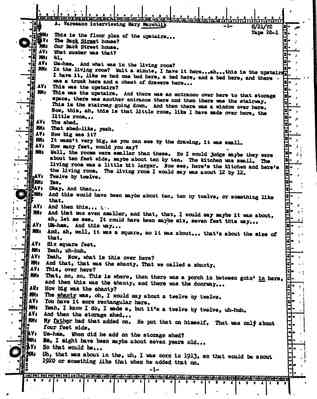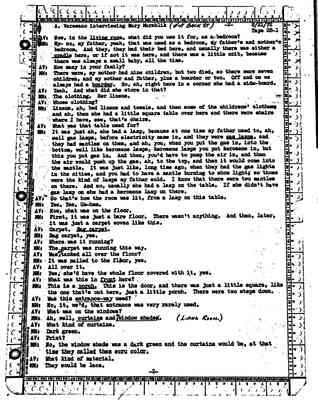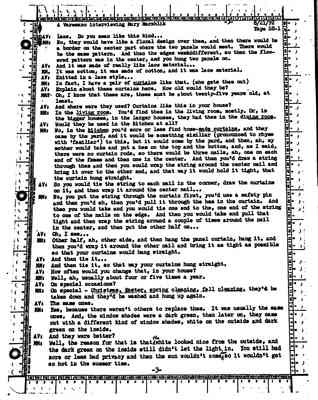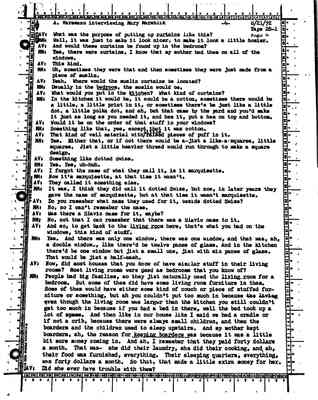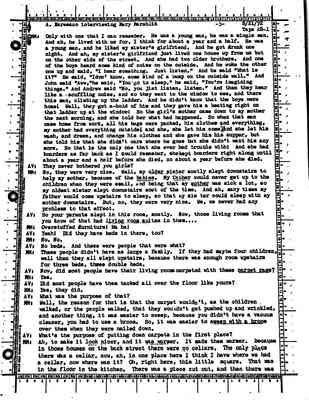Pages
3
A. Varesano interviewing Mary Marshlik 8/21/72 Tape 28-1 MM: This is the floor plan of the upstairs... AV: The Back Street house? MM: Our Back Street house. AV: What number was that? MM: 41. AV: Um-hmm, And what was in the living room? MM: In the living room? Wait a minute, I have it here...ah...this is the upstairs. I have it, like we had one bed here, a bed here, and a bed here, and there was a trunk here and a chest of drawers here... AV: This was the upstairs? MM: This was the upsatirs. And there was an entrance over here to that storage space, there was another entrance there and then there was the stairway. This is the stairway going down. And then there was a window over here. Now, this, ah, this is that little room, like I have made over here, the little room... AV: The shed. MM: That shed-like, yeah. AV: How big was it? MM: It wasn't very big, as you can see by the drawing, it was small. AV: How many feet, would you say? MM: Well, the rooms were smaller than these. So I would judge maybe they were about ten feet wide, maybe about ten by ten. The kitchen was small. The living room was a bit larger. Now see, here's the kitchen and here's the living room. The living room I would say was about 12 by 12. AV: Twelve by Twelve. MM: Yes. AV: Okay. And then... MM: And this would have been maybe about ten, ten by twelve, or something like that. AV: And then this... MM: And that was even smaller, and that, that, I would say maybe it was about, ah, let me see. It could have been maybe six, seven feet this way... AV: Um-hmm. And this way... MM: And, ah, well it was a square, so it was about... that's about the size of that AV: Six square feet. MM: Yeah, uh-huh AV: Yeah. Now what is this over here? MM: And that, that was the shanty. That we called a shanty. AV: This, over here? MM: That, no, no. This is where, then there was a porch in between goin' in[underlined] here, and then this was the shanty, and there was the doorway... AV: How big was the shanty? MM: The shanty[underlined] was, oh, I would say about a twelve by twelve. AV: You have it more rectangular here. MM: Yeah, I know I do, I made a, but it's a twelve by twelve, uh-huh. AV: And then the storage shed... MM: My father[underlined] had that added on. He put that on himself. That was only about four feet wide. AV: Um-hmm. When did he add on the storage shed? MM: Mm, I might have been maybe about seven years old... AV: So that would be... MM: Uh, that was about in the, uh, I was born in 1913, so that would be about 1920 or something like that when he added that on.
4
A. Varesano interviewing Mary Marshlik (#41 Back St) 8/21/72 Tape 28-1 AV: Now, in the living room [underlined], what did you use it for, as a bedroom? MM: My- no, my father, yeah, that was used as a bedroom, my faather's and mother's bedroom. And they, they had their bed here, and usually there was either a cradle here, or if not it was here, and there was a little crib, because there was always a small baby, all the time. AV: How many in your family? MM: There were, my mother had nine children, but two died, so there were seven children, and my mother and father, plus a boarder or two. Off and on we always had a boarder [underlined]. So, ah, right here in a corner she had a side-board. AV: Yeah. And what did she store in that? MM: The clothing. Her linens. AV: Whose clothing? MM: Linens, ah, bed linens and towels, and then some of the children's clothes and ah, then she had a little square table over here and there were chairs where I have, see, that's chairs. AV:What was that table used for? MM: It was just ah, she had a lamp, because at one time my father used to, ah, sell gas lamps, before electricity came in, and they were gas lamps [underlined], and they had mantles on them, and ah, you, when you put the gas in, into the bottom, well like kerosene lamps, kerosene lamps you put kerosene in, but this you put gas in. And then, you'd have to pump the air in, and then the air would push up the gas, ah, to the top, and then it would come into the mantle. It was just like, long time ago, when they had the gas lights in the cities, and you had to have a mantle burning to show light, so those were the kind of lamps my father sold. I know that there were two mantles on there. And so, usually she has a lamp on the table. If she didn't have gas lamp on she had a kerosene lamp on there. AV: So that's how the room was lit, from a lamp on this table. MM: Yes. Yes. Um-hmm. AV: Now, what was on the floor. MM: First, it was just a bare floor. There wasn't anything. And then, later, it was just a carpet woven like this. AV: Carpet. Bag Carpet [underlined]. MM: Bag carpet, yes. AV: Where was it running? MM: The carpet was running this way. AV: Was [it] tacked all over the floor? MM: It was nailed to the floor, yes. AV: All over it. MM: Yes, she'd have the whole floor covered with it, yes. AV: What was this in front [underlined] here? MM: This is a porch [underlined]. This is the dorr, and there was just a little square, like the one that's out here, just a little porch. There were two steps down. AV: Was this entrance-way [underlined] used? MM: No, it, we'd, that entrance was rarely used. AV: What was on the windows? MM: Ah, well, curtains [underlined] and [a] window shade [underlined]. (Living Room.) AV: What kind of curtains. MM: Dark green. AV: Print? MM: No, the window shade was a dark green and the curtains would be, at that time they called them ecru color. AV: What kind of material. MM: They would be lace.
5
A. Varesano interviewing Mary Marshlik 8/21/72 Tape 28-1 AV: Lace. Do you mean like this kind... MM: No, they would have like a floral design over them, and then there would be a border on the center part where the two panels would meet. There would be the main pattern. And then the edges were different, so then the flow-ered pattern was in the center, and you hang two panels on. AV: And it was made of really like lace material... MM: It was cotton, it was made of cotton, and it was lace material. AV: Knitted in a lace style... MM: In fact, I have a pair of curtains (underlined) like that. (she gets them out) AV: Explain about these curtains here. How old would they be? MM: Oh, I know that these are, these must be about twenty-five years old, at least. AV: And where were they used? Curtains like this in your house? MM: In the living room (underlined). You'd find them in the living room, mostly. Or, in the bigger houses, in the larger houses, they had them in the dining room (underlined). AV: Would they be used in the kitchen at all? MM: No, in the kitchen (underlined) you'd more or less find home-made curtains, and they came by the yard, and it would be something similiar (pronounced to rhyme with 'familiar') to this, but it would come by the yard, and then, ah, my mother would take and put a hem on top and the bottom, and, as I said, there were no curtain rods, so there would be three nails, ah, one on each end of the frame and then one in the center. And then you'd draw a string through them and then you would wrap the string around the center nail and bring it over to the other end, and that way it would hold it tight, that the curtain hung straight. AV: So you would tie the string to each nail in the corner, draw the curtains on it, and then wrap it around the center nail... MM: No, you put the string through the curtain first, you'd use a safety pin and then you'd ah, then you'd pull it through them hem in the curtain. And then you would take and you would tie one end to the, one end of the string to one of the nails on the edge. And then you would take and pull that tight and then wrap the string around a couple of times around the nail in the center, and then put the other half on... AV: Oh, I see... MM: Other half, ah, other side, and then hang panel curtain, hang it, and then you'd wrap it around the other nail and bring it as tight as possible so that your curtains would hang straight. AV: And then tie it... MM: And then tie it, so that way your curtains hung straight. AV: How often would you change that, in your house? MM: Well, ah, usually about four or five times a year. AV: On special occasions? MM: On special - Christmas, Easter, spring cleaning, fall cleaning, they'd be taken down and they'd be washed and hung up again. AV: The same ones. MM: Yes, because there weren't others to replace them. It was usually the same ones. And, the window shades were a dark green, then later on, they came out with a different kind of window shades, white on the outside and dark green on the inside. AV: And they were better? MM: Well, the reason for that is that the white looked nice from the outside, and the dark green on the inside still didn't let the light in. You still had more or less had privacy and then the sun wouldn't come in so it wouldn't get so hot in the summer time.
6
A. Varesano interviewing Mary Marshlik 8/21/72 Tape 28-1 AV: What was the purpose of putting up curtains like this? Page 4 MM: Well, it was just to make it look nicer, to make it look a little homier. AV: And these curtains be found up in the bedroom? MM: Yes, there were curtains, I know that my mother had them on all of the windows. AV: This kind. MM: Uh, sometimes they were that and then sometimes they were just made from a piece of muslin. AV: Yeah. Where would the muslin curtains be located? MM: Usually in the bedroom [underlined], the muslin would be. AV: What would you put in the kitchen [underlined]? What kind of curtains? MM: In the kitchen it would be, it would be a cotton, sometimes there would be a little, a little print in it, or sometimes there'd be just like a little dot, a little polka dot, and ah, but that came by the yard and you'd make it just as long as you needed it, and hem it, put a hem on top and bottom. AV: Would it be on the order of that stuff in your windows? MM: Something like that, yes, except that it was cotton. AV: That kind of veil material with little raised pieces of puff in it. MM: Yes. Either that, or if not there would be a-jist a like-a-squares, little squares. Jist a little heavier thread would run through to make a square design. AV: Something like dotted Swiss. MM: Yes. Yes, uh-huh. AV: I forgot the name of what they call it, is it marquisette. MM: Now it's marquisette, at that time it wasn't. AV: They called it something else. MM: It was, I think the did call it dotted Swiss, but now, in later years they gave the name of marquisette, but at that time it wasn't marquisette. AV: Do you remember what name they used for it, beside dotted Swiss? MM: No, no I can't remember the name. AV: Was there a Slavic name for it, maybe? MM: No, not that I can remember that there was a Slavic name to it. AV: And so, to get back to the living room [underlined] here, that's what you had on the windows, this kind of stuff. MM: Yes. And there was only one window, there was one window, and that was, ah, a double window, like there'd be twelve panes of glass. And in the kitchen there'd be one window but jist a small one, jist with six panes of glass. That would be jist a half-sash. AV: Now, did most houses that you know of have similar stuff in their living rooms? Most living rooms were used as bedrooms that you know of? MM: People had big families, so they jist naturally used the living room for a bedroom. But some of them did have some living room furniture in them. Some of them would have either some kind of couch or piece of stuffed fur-niture or something, but ah you couldn't put too much in because the living even though the living room was larger than the kitchen you still couldn't get too much in because if you had a bed in there, well the bed took up a lot of space. And then like in our house like I said we had a cradle of if not a crib, because there were always small children, and then the boarders and the children used to sleep upstairs. And my mother kept boarders, ah, the reason for keeping boarders [underlined] was because it was a little bit more money coming in. And ah. I remember that they paid forty dollars a month. That was- she did their laundry, she did their cooking, and ah, their food was furnished, everything. Their sleeping quarters, everything was forty dollars a month. So that, that made a little extra money for her. AV: Did she ever have trouble with them?
7
A. Maresano interviewing Mary Marshlik 8/21/72 Tape 28-1 MM: Only with one that I can remember. He was a young man, he was a single man. And ah, he lived with us for, I think for about a year and a half. He was a young man, and he liked my sister's girlfriend. And he got drunk one night. And ah, my sister's girlfriend just lived one house up from us but on the other side of the street. And she had two older brothers. And one of the boys heard some kind of noise on the outside. And he woke the other one up and said, "I hear something. Just listen." And he said "What is it?" He said, "I don' know, some kind of a bump on the outside wall." And John said "Aww," he said, "You go to sleep," he said, "You're imagining things." And Andrew said "No, you jist listen, listen." And then they hear like a scuffling noise, and so they went to the window to see, and there this man, climbing up the ladder. And he didn't know that the boys were home! Well, the got a-hold of him and they gave him a beating right on that ladder up at the window! So the girl's mother came down to my mother the next morning, and she thold her what had happened. So when that man came home from work, all his bags were packed, his clothes and everything, my mother had everything outside and she, she let him come and she let him wash, and dress, and change his clothes and she gave him his supper, but she told him that she didn't care where he goes but she didn't want him any more. So that is the only one that she ever had trouble with! And she has boarders as far back as I could remember, she kept boarders right along until about a year and a half before she died, no about a year before she died. AV: They never bothered you girls? MM: No, they were very nice. Well, my older sister [underlined] mostly slept downstairs to help my mother, because of the babies [underlined]. My father [underlined] would never get up to the children when they were small, and being that my mother [underlined] was sick a lot, so my oldest sister slept downstairs most of the time, And ah, many times my father would come upstairs to sleep, so that my sister could sleep with my mother downstairs. But, no, they were very nice. We, we never had any problems to that effect. AV: So your parents slept in this room, mostly. Now, those living rooms that you know of that had living room suites [underlined] in them.... MM: Overstuffed furniture! Ha ha! AV: Yeah! Did they hae beds in there, too? MM: No. No. AV: No beds. And these were people that were what? MM: These people didn't have as large a family. If they had maybe four children, well then they all slept upstairs, because there was enough room upstairs for three beds, three double beds. AV: Now, did most people have their living rooms carpeted with these carpet rags [underlined]? MM: Yes. AV: Did most people have them tacked all over the floor like yours? MM: Yes, they did. AV: What was the purpose of that? MM: Well, the reason for that is that the carpet wouldn't, as the children walked, or the people walked, that they wouldn't get pushed up and wrinkled, and another thing, it was easier to sweep, because you didn't have a vacuum cleaner, you had to use a broom. So, it was easier to sweep with a broom [underlined] over them when they were nailed down. AV: What's the purpose of putting down carpets in the first place? MM: Ah, to make it look nicer [underlined], and it was warmer [underlined]. It made them warmer. Because in those houses on the back street there were no cellars. The only place there was a cellar, now, ah, in one place here I think I have where we had a cellar, now where was it? Oh, right here, this little square. That was in the floor in the kitchen. There was a piece cut out, and then there was
